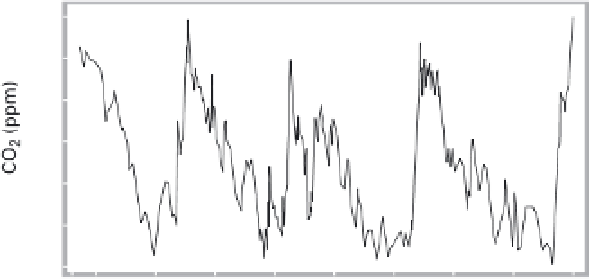Environmental Engineering Reference
In-Depth Information
11.8 Atmospheric CO
2
concentrations, (
a
) during the past
420,000 years, derived from ice core bubbles (Petit et al.
1999), and (
b
) since 1958 as monthly averages (tracing the
annual biospheric breath) of continuous measurements at
Mauna Loa. Plotted from data in Keeling (1998) and Carbon
Dioxide Information Analysis Center.
Loa and at the South Pole (Keeling 1998). In 1958 the
CO
2
level at Mauna Loa averaged 320 ppm; by 2000 it
surpassed 370 ppm (fig. 11.8).
To this must be added the thermal burden of other
anthropogenic greenhouse gases (GHG) whose com-
bined forcing is now roughly equal to that of CO
2
(Han-
sen et al. 2000). While the atmospheric concentrations of
these gases are much lower than those of CO
2
, the spe-
cific absorption rates of the outgoing infrared radiation
(that is, their global warming potential, GWP) greatly
surpass that of CO
2
. The natural gas industry (field losses
during extraction, flaring, pipeline leaks) and coal mining
are major sources of methane, the second most impor-
tant anthropogenic GHG (GWP
¼
270), which is also
produced by anaerobic fermentation in rice fields and
landfills and by enteric fermentation of ruminant live-
stock. As a result, CH
4
levels have roughly doubled since
1850, to about 1.7 ppm by the year 2000. Emissions of
N
2
O, the third most important anthropogenic GHG
(GWP
¼
60), originate mainly from denitrification and
fossil fuel combustion.
Compared to 1880, the combined forcing of all GHGs
reached nearly 3 W/m
2
by 2000 and 3.05 W/m
2
by
2003 (fig. 11.9) (Hansen et al. 2000; 2005). Black
carbon added nearly 0.5 W/m
2
, but the net effect of
anthropogenic aerosols was to cool the Earth at
1.39
W/m
2
. Adding the effects of land use and snow albedo
produced overall forcing of 1.8 (G0.85) W/m
2
relative
to 1880 and climate sensitivity of 0.6
C-0.7
C/W
m
2
.
This is actually the observed 1880-2003 warming in full
response to nearly 1 W/m
2
of past forcing, while about
0.85 W/m
2
is yet to have its effect; additional warming






























